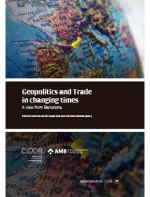Technological revolution and international trade 4.0

The central role of technology in the take-off and subsequent consolidation of international trade is clear to anyone with a little historical perspective. With the sole interruption of the interwar period, trade flows have grown dramatically since 1820, supported by various industrial revolutions and advances in the fields of transport and information and communication technologies (ICT). In the most recent phase, the enormous ICT advances seen since the 1990s have allowed companies to slice up their production processes and place different parts in different countries to take advantage of the specialisations of each. This has given rise to what have become known as global value chains (GVCs), which have driven international trade to volumes that were unthinkable a few decades ago.
Whether this trend will continue is less clear. The relentless evolution of information and communication technologies – now embracing 5G and blockchains – may continue to encourage international trade to grow as it has over the last two hundred years. But other recent technological advances, such as those in automation, the electric car and 3D printing, could reverse some GVCs and reduce trade.